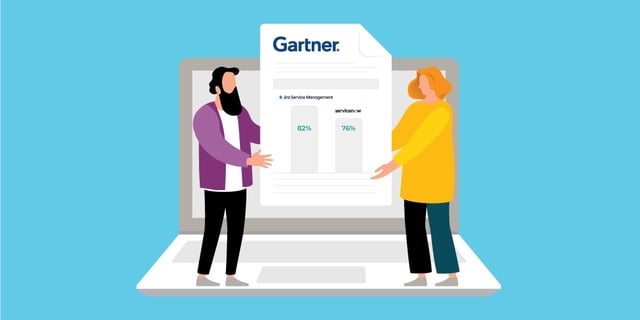Gartner Peer Insights is a trusted platform for ratings and reviews of enterprise technology solutions left by end-user professionals, for end-user professionals.
Gartner Peer Insights is a trusted platform for ratings and reviews of enterprise technology solutions left by end-user professionals, for end-user professionals.
With 340 categories covered, 5,500 products and 250,000 reviews – Gartner Peer Insights is one of the largest, reputable peer-based research services for IT. Reviews are meticulously vetted by Gartner, the world’s leading research and advisory company — no vendor bias, hidden agendas, just the real voices of enterprise users.
A little while ago, we shared a comparison blog on Jira Service Desk and ServiceNow, encouraging our readers to make the choice themselves. We’d like to share some game-changing information that may sway your decision.
The Proof
It’s been suggested JSD is the more advanced solution of the two, being the most integrated Service desk product in the business for 20% of the cost of ServiceNow, but don’t take our word for it.
Separating fact from opinion is always a challenge, but the reality is, most people will make decisions based on real evidence, as opposed to biased viewpoints. So let’s take a look at the facts, shall we?
Jira Service Desk was recommended by 82% of peer reviewers, beating ServiceNow by 6%. ServiceNow received 76% of reviews in favour of their solution.
In addition to this, JSD surpassed SN in 11 categories of reporting, deadlocking a further 2, and receiving zero losses.
The Big Wins
Food for thought — there are more reviews from the largest segment of customers for JSD than there are for ServiceNow. We’ll leave you to form your own opinion based on that.
The biggest areas of success were:
- Evaluation and pricing
- Reporting
- SLA Management
- Integration and deployment
- Service and support
How did this happen?
As you may or may not know, ServiceNow has a significantly smaller install base with some 5000-6000 customers. Jira Service Desk, on the other hand, has over 25,000 customers.
Despite this, it has been suggested that Jira Service Desk is preferred by small-scale businesses, this is likely down to the fact that the cost of JSD is a lot more competitive than SN.
On top of this, Jira Service Desk is innovating faster and has a newer interface than SN. Due to the fact Atlassian will sell ten agents or one thousand, they have a larger customer base and more input and, therefore, a greater demand for features. Atlassian doesn’t spend money on expensive sales reps or consulting teams, leaving that to their partners. This means they can spend more core R&D on products.
In all fairness, ServiceNow came into the game early on, snatching up some of the biggest clients with a sophisticated cloud offering. Over time, however, they’ve been unable to sustain an all-guns-blazing approach, with overpriced enterprise costs, a dated interface, a lack of direct integration with IT teams and limited flexibility. All of these aspects have pushed customers to see the truth; you can get more for your money for 20% of the spend, with software companies such as VMware replacing Service Now with Jira Service Desk.
VMware switched to JSD after seeing Riada’s Insight, a powerful Atlassian App combining world-class CMDB (Change Management Database) with asset tracking. Many teams benefit from Insight, using it for all types of apps, including CRM.
How did this happen?
Are you using ServiceNow, but like VMware, you’d like to switch to Jira Service Desk? We can help. The process goes a little something like this:
Discovery > Proof of Concept — where we prototype the JSD config and workflows > Pilot – normally a soft launch of the tool > then Go Live; plus training and consultancy on JSD, Confluence and Insight.
Published: Aug 20, 2019
Updated: Mar 26, 2024


